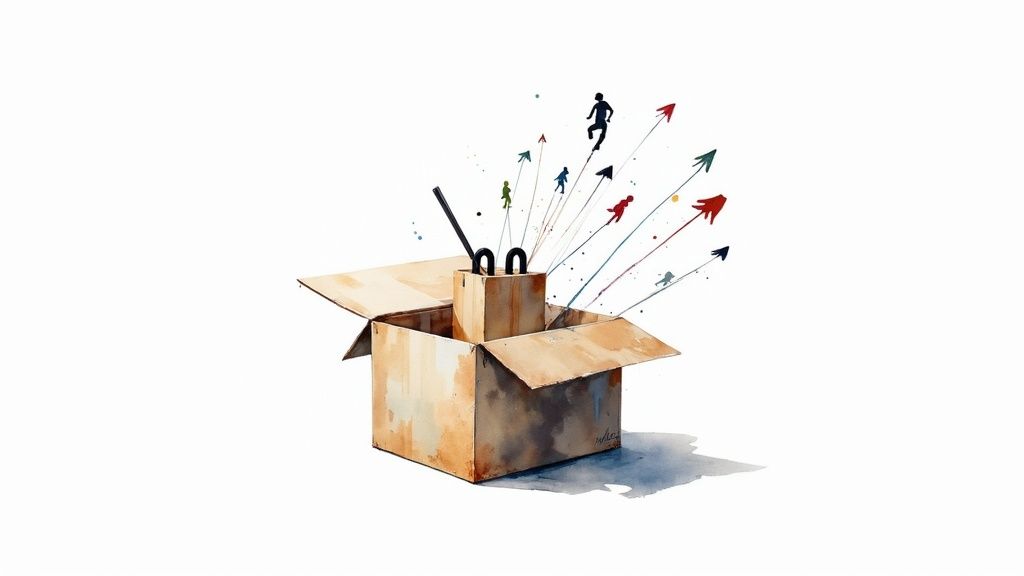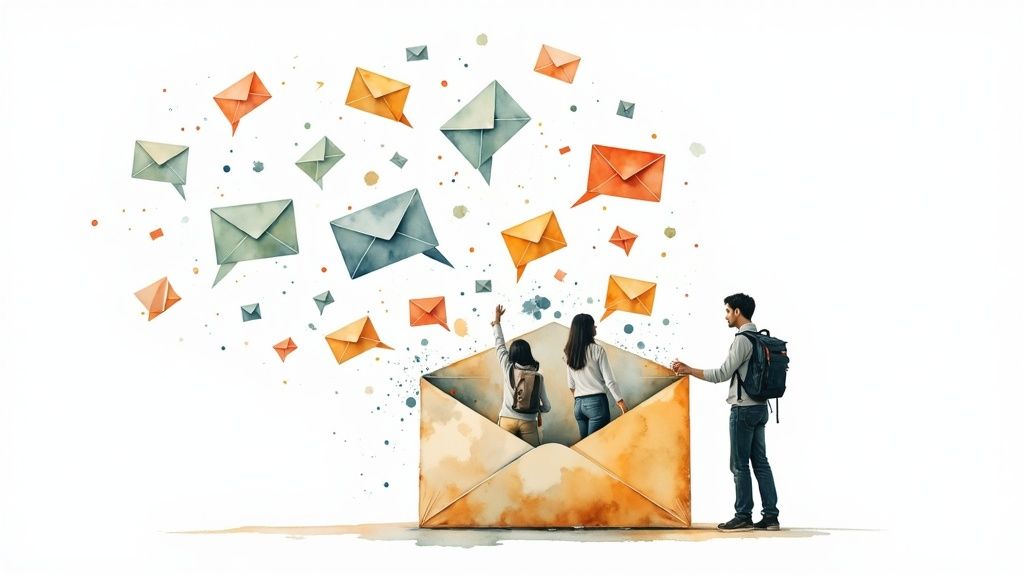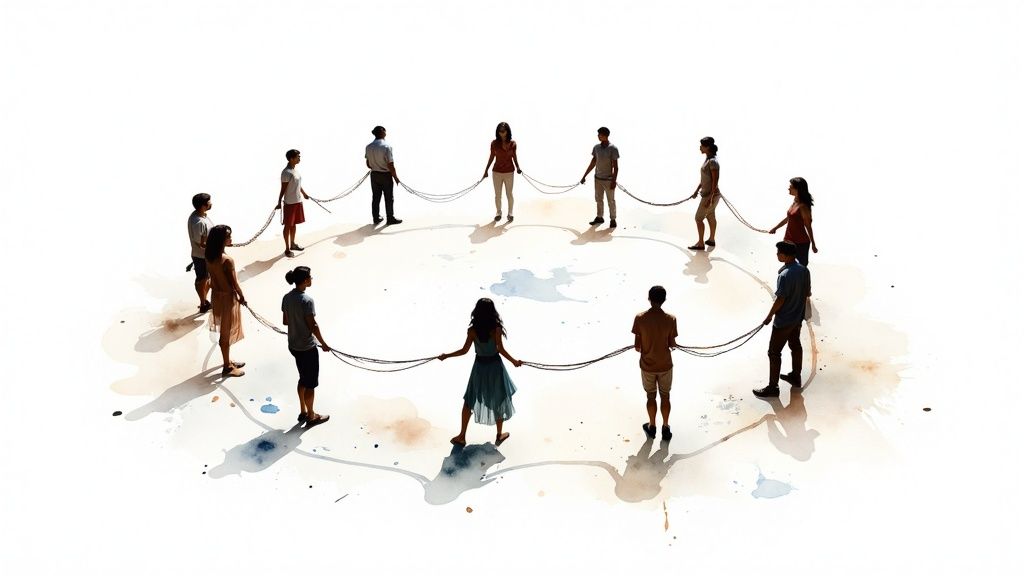Your SaaS Retention Sucks. Here's How to Fix It.
Discover effective SaaS customer retention strategies to boost loyalty and growth in 2025. Learn proven techniques to retain customers and increase revenue.
Posted by
Let's be honest. You're obsessed with your acquisition funnel but your product is a leaky bucket. You celebrate new sign-ups while your paying customers slip out the back door, and you have the audacity to call it "acceptable churn." That's not churn; it's a slow, self-inflicted death. Every dollar you spend on Google Ads is set on fire the moment that user cancels. Ignore the customers you have, and you'll be lucky to survive the quarter.
We're not going to talk about 'delighting users' or other fluffy conference nonsense. We're going to talk about the hard, unsexy, profitable work of actually keeping the customers you already bled for. This isn't about feel-good metrics; it’s about plugging the holes in your revenue bucket so you can finally start filling it. The difference between a startup that prints cash and one that constantly scrambles for funding is its obsession with retention.
If you think retention is a 'nice-to-have,' close this tab and go write another "we're excited to announce" blog post about your next funding round. If you're ready to build a business that actually lasts, let's get into the real SaaS customer retention strategies that separate the rocket ships from the wreckage.
1. Stop Guessing. Build a Real Customer Success Machine.
Let's get one thing straight: if you think Customer Success is just a fancy name for customer support, you're already dead in the water. Support is reactive; it cleans up messes. A real Customer Success team is a proactive, revenue-defending unit obsessed with making your product so indispensable that leaving feels like self-sabotage.
Your CSMs aren't there to answer emails politely. They're your forward operating base in enemy territory, and the enemy is churn. They hunt for red flags before they become cancellation tickets. They sniff out expansion revenue while your sales team is still chasing cold leads. If your CSMs are just reacting, you don't have a strategy; you have a very expensive help desk.

Why It Works Like a Charm
It’s not about being "nice"; it's about making your tool essential to their bottom line. Gainsight uses its own platform to get over 95% retention because they force-feed their own medicine. It works. This isn't just about reducing churn; it’s about turning happy customers into your best growth engine. They stop asking "is this worth it?" and start asking "how can we use this more?"
The Takeaway: Invest in proactive CSMs, or prepare to perpetually replace every customer you acquire.
Your Action Plan
- Implement Health Scoring: Stop guessing who's at risk. Create a score based on product usage, feature adoption, and support tickets. This turns your intuition into a data-driven early warning system.
- Map the Journey: Chart every touchpoint. Identify the "moments of truth" where they either see massive value or get pissed off and stall. Focus your CSMs there.
- Define Success, Then Track It: Work with customers to set clear KPIs for what "success" with your tool looks like. Then, hold quarterly reviews to prove you're delivering.
- Train for Business, Not Just Buttons: Your CSMs need to be consultants who understand your customers' industries, not just product experts who can explain where to click.
2. Onboarding Isn't a Tour, It's a Rescue Mission.
Your first impression isn't your homepage; it's the first five minutes after signup. If your onboarding feels like assembling IKEA furniture without instructions, you've already lost. Onboarding isn't a "nice-to-have" product tour; it's a mission-critical operation to get your customer to their "aha moment" so fast they forget they ever lived without you. Fail here, and you’re funding your competitor's marketing budget with your churned revenue.
A sloppy onboarding experience tells the customer you don't respect their time. It creates friction, doubt, and buyer's remorse before they’ve even seen your product's real value. This is one of the most powerful SaaS customer retention strategies because it tackles churn before it has a chance to fester.

Why It Works Like a Charm
Great onboarding isn't about showing off every feature. It's about guiding the user to a quick, meaningful win. Slack doesn't start with advanced integrations; it gets you to send your first message. Canva pushes you to create a design in seconds. Initial momentum is everything. To truly fix your onboarding, implement proven client onboarding best practices that ensure a smooth start. This cements your product's value from day one.
The Takeaway: The battle for retention is won or lost in the first session.
Your Action Plan
- Define the "Aha Moment": Identify the single action that makes a user think, "Wow, I need this." Engineer your entire onboarding flow to get them there with zero friction.
- Use Progressive Disclosure: Don't overwhelm users. Show them the steering wheel and gas pedal first, not the engine schematic. Introduce functionality contextually as they need it.
- Create Role-Specific Paths: A developer using your API needs a different first-run experience than a marketer. Tailor onboarding to the user's specific job-to-be-done.
- Track Onboarding Metrics Relentlessly: Monitor time-to-first-value (TTFV), completion rates for key events, and drop-off points. Then, optimize ruthlessly.
3. Don’t Sell. Let the Product Do the Talking with PLG.
If you think your sales team is the only way to grow, you're building a company with an expiration date. Sales-led growth is a constant, expensive grind. Product-Led Growth (PLG) flips the script. Your product isn't just what you sell; it's the engine for acquisition, conversion, and expansion. The experience is so self-evidently valuable that users onboard themselves and pull out their credit cards without ever talking to a human.
This isn't about giving away free stuff; it's about engineering your product to create its own demand. Slack didn't become a verb by cold-calling IT managers. They let teams use it for free, get hooked, and then hit a natural upgrade point. PLG is one of the most powerful SaaS customer retention strategies because retention is baked into the very first click.

Why It Works Like a Charm
PLG creates a frictionless path to value. When users can solve a real problem in minutes, you’ve won half the battle. Dropbox gave away free storage for referrals, turning its user base into its most effective sales team. Zoom's free 40-minute meetings let entire organizations adopt the tool organically before a single invoice was sent. You only grow when they find undeniable value.
The Takeaway: Stop forcing demos and build a product that sells itself.
Your Action Plan
- Engineer for "Aha!": Obsessively analyze user behavior to find the "Aha!" moment. Your entire new user experience should be a high-speed ramp to that single moment.
- Weaponize Your Free Tier: Your free plan isn't a charity. It's a strategic weapon. Design it to showcase your core value while creating natural, value-based limitations that drive upgrades.
- Build-In Virality: Don’t just ask for shares; build sharing into the workflow. Figma's collaborative design means the product's value increases as more team members join.
- Use In-App Nudges: Guide users toward valuable features and upgrade paths with contextual, in-app messaging. Trigger tooltips based on user actions, turning them into timely advice instead of disruptive ads.
4. Personalized Communication and Engagement
Stop blasting your entire user base with the same generic email. It’s lazy, disrespectful, and the digital equivalent of shouting into a void. If you treat a power user and a new trial user the same, you’re not engaging anyone. You’re just creating noise, and they're hitting unsubscribe faster than you can say "churn." Personalized communication is not a "nice-to-have"; it's a non-negotiable weapon.
This is one of the most effective SaaS customer retention strategies because it proves you're paying attention. It’s the difference between a form letter and a handwritten note. Use data on behavior, lifecycle stage, and usage patterns to send messages so relevant they feel like a one-on-one conversation.

Why It Works Like a Charm
Personalization shatters indifference. Netflix doesn't just have a library of content; it has your library. Spotify's "Discover Weekly" uses listening habits to create a playlist so good it feels like magic. In B2B, HubSpot triggers email sequences based on the specific features you use or neglect, nudging you toward greater value. They build loyal fans by making their service feel uniquely theirs.
The Takeaway: Speak to everyone, and you speak to no one.
Your Action Plan
- Segment Before You Personalize: Your first step isn't hyper-personalization; it's basic segmentation. Group users by lifecycle stage (trial, new, power user, at-risk), plan type, or key feature adoption.
- Trigger In-App Messages: Use behavioral triggers. If a user tries a new feature, hit them with a pop-up offering a quick tip. If they seem stuck, trigger a link to a help doc.
- Leverage Progressive Profiling: Don't kill conversion with long sign-up forms. Ask for information over time. To do this right, you need to understand how to get customer feedback. Get practical advice on collecting user insights on backsy.ai.
- Balance Automation and Human Touch: Automate triggered messages for common behaviors, but flag high-value customers who show signs of trouble for a personal outreach from a CSM.
5. Loyalty Programs and Incentives
Let’s be clear: a SaaS loyalty program isn't about giving away cheap t-shirts. That’s retail thinking, and it’s lazy. In SaaS, loyalty isn’t bought with discounts; it's earned by making your customer a hero in their own company. A real loyalty program turns your best users into evangelists and makes your platform a non-negotiable part of their professional identity.
Forget punch cards. Your program should offer exclusive access, professional credentials, and career benefits that make sticking with you a smart business decision. This is one of the most underutilized SaaS customer retention strategies because most founders think it’s fluff. It’s not. It’s about building a moat around your best customers so deep your competitors can't see across it.
Why It Works Like a Charm
A well-executed loyalty program creates powerful switching costs. Salesforce's Trailblazer Community gives users badges, peer recognition, and a path to better jobs. An admin with a dozen Salesforce Ranger badges isn't just a user; they're a credentialed expert. Adobe's certification programs turn designers into certified professionals, tying their career success directly to Adobe's products.
The Takeaway: Stop bribing customers with discounts. Reward them with status and career advancement.
Your Action Plan
- Reward Value, Not Just Tenure: Instead of rewarding customers for simply not churning, incentivize behaviors that create value: mastering advanced features, referring leads, or beta-testing.
- Create Tiers of Exclusivity: Structure your program with clear progression paths. A new user gets a private Slack channel, while a "power user" gets early access to new features or invites to exclusive events.
- Focus on Professional Development: Offer certifications and training that help your users get better at their jobs, not just better at using your tool.
- Build a Community, Not a Forum: Foster a real community where your best customers can connect and share best practices. A strong community is the ultimate defense against churn.
6. Your Support Team is a Leaky Bucket. Plug It with Proactive Outreach.
If your support team’s primary job is waiting for tickets, you’re not running a support department; you’re managing a digital fire station. You’re paying people to wait for something to burn down. Proactive support flips this broken model. It’s about anticipating where a customer will get stuck and intervening before they even think about clicking "Help."
This isn't about being psychic. It's about using data to find the tripwires in your user experience. It shifts your support function from a cost center that cleans up messes to a retention engine that prevents them. This is one of the most powerful SaaS customer retention strategies because it addresses churn before it festers.
Why It Works Like a Charm
Proactive support shows you're paying attention. Intercom excels at this, using in-app messages to guide users who hesitate on a key feature, preemptively solving a problem they didn't know they had. This builds immense trust and makes your service feel less like a tool and more like an active partner.
The Takeaway: Hunt down customer problems before they happen and you'll make leaving unthinkable.
Your Action Plan
- Weaponize Your Data: Implement customer health scoring. Track login frequency, feature adoption, and time spent on certain pages. A sudden drop is a flare signaling a customer is lost.
- Automate the First Touch: Create automated workflows for common failure points. Is a user repeatedly failing to set up an integration? Trigger an email with a guide. AI's role in empowering customer support can help you predict these moments.
- Listen for Future Problems: Scour support tickets, NPS comments, and cancellation surveys for patterns. If ten customers struggled with the same report, that’s your next proactive campaign.
- Balance Bots with Brains: Use automation to identify the "who" and "what," but empower your human team to handle the "why." A well-timed, personal check-in is infinitely more powerful than a bot alone.
7. Value-Based Pricing and Packaging
Stop selling your product like it's a commodity. If you're just adding a 30% margin to your server costs, you're telling customers your value is negotiable. Value-based pricing flips the script. You don't charge based on your costs; you charge based on the value, ROI, and outcomes your customers achieve.
This isn't about gouging clients. It's about aligning your revenue model with their success. When they grow, you grow. When they see a 10x return, your price becomes a rounding error. This is one of the most powerful SaaS customer retention strategies because it makes your pricing a reinforcement of value, not a point of friction.
Why It Works Like a Charm
Value-based pricing anchors your product's cost to the customer's success. This reframes the renewal conversation from "Is this tool too expensive?" to "Can we afford to lose the value this tool provides?" HubSpot's pricing, tied to contact volume, ensures that as a customer's marketing succeeds, they seamlessly scale. The price feels fair because it grows in lockstep with the value delivered.
The Takeaway: Tie your price to the value you create, and you'll never have to compete on price again.
Your Action Plan
- Interview for Value, Not Features: Stop asking what features they like. Ask how your product makes them money or saves them time. Quantify it. "How much time does this save your team per week?"
- Create Natural Upgrade Paths: Design your pricing tiers so the next level up is a logical step for a growing customer. The features in the higher tier should solve the problems they're about to have.
- Use Data to Define Tiers: Don't guess your pricing boundaries. Analyze usage data to find the natural breakpoints where customers start needing more power or advanced features.
- Offer Annual Incentives: Once a customer understands your value, make it easy to commit. Offer a meaningful discount (10-20%) for an annual contract. It locks in revenue and improves cash flow.
8. Build a Cult, Not Just a Customer List.
Let’s be brutally honest: your product isn't special enough to survive on features alone. Someone with more funding will copy your roadmap. The only sustainable moat is a network of users so invested in each other and your brand that leaving feels like abandoning their tribe. This isn't about creating a forum to dump support tickets; it's about engineering a sense of belonging.
A community turns passive users into active evangelists. They solve problems for each other, reducing your support load. They share resources, making your product more valuable. Failing to build a community isn't a missed opportunity; it's a strategic blunder. This is one of the most powerful SaaS customer retention strategies because it creates emotional connections that transcend feature comparisons.
Why It Works Like a Charm
A thriving community creates a powerful network effect. The more users who join, the more valuable it becomes. Salesforce didn't just build a CRM; they built the Trailblazer Community, a global network of millions who help each other and build careers. Figma's community freely shares templates and plugins, exponentially increasing the platform's utility.
The Takeaway: Stop selling a tool and start facilitating a movement.
Your Action Plan
- Anoint Your Apostles: Identify your most passionate users and give them a megaphone. Make them "ambassadors." Give them early access, special status, and a direct line to your team.
- Fuel the Fire with Value: Your community needs a reason to exist beyond your product. Host expert AMAs or run challenges that help them achieve their professional goals.
- Reward Participation, Not Just Presence: Publicly recognize members who contribute value. A "member of the month" spotlight or a swag pack can transform lurkers into leaders.
- Connect People, Not Just Ideas: Act as a matchmaker. When you see two users with similar challenges, introduce them. Fostering these peer-to-peer relationships is the bedrock of a loyal community.
Stop Admiring the Problem and Actually Do Something
There you have it. Eight battle-tested SaaS customer retention strategies. This isn't a buffet where you pick one or two items. This is the blueprint for a business that doesn't just survive, it thrives. Your competitors are busy chasing vanity metrics while ignoring the gaping hole at the bottom where paying customers are bleeding out. That’s your opening.
Let’s be honest: retention is messy, unglamorous work. It’s harder than shipping a sexy new feature. But it's the only work that matters. The difference between a business that hits a valuation ceiling and one that compounds its growth is a relentless, obsessive focus on keeping the customers you’ve already earned.
Pick one strategy and execute it ruthlessly. If your churn is highest in the first 30 days, your onboarding is broken. Fix it. If your support team is always underwater, you’re being reactive. Fix it. The common thread is a deep, authentic understanding of your customer. You can't guess the answers. You have to listen.
Ignoring your customers is a death sentence, executed one cancellation at a time. Your job isn't to invent a retention miracle; it's to stop, listen, and then have the guts to act on what you hear.
Quit guessing what your customers are thinking and start building a retention engine fueled by real user feedback with Backsy.ai to see what they're really telling you in under 10 minutes.